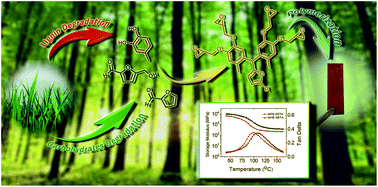Renewable thermoset polymers based on lignin and carbohydrate derived monomers†
Abstract
With limited current biomass utilization as a renewable resource, it is important to develop a method to convert biomass into materials to replace fossil fuel products. In this article, lignin and carbohydrate derived monomers, including 4-methylcatechol, 5-hydroxymethylfurfural (HMF), and furfural, were used to prepare bisphenol–furan type polyphenols. Epoxy networks were synthesized from different polyphenol monomers via glycidylation and curing steps under identical reaction conditions. The structures of bisphenol–furan trinuclear compounds, epoxide precursors, and cured epoxy polymer networks were characterized by nuclear magnetic resonance spectroscopy (NMR), Fourier transform infrared spectroscopy (FTIR) and high resolution mass spectrometry (MS). Differential scanning calorimetry (DSC), thermogravimetric analysis (TGA), and dynamic mechanical analysis (DMA) were conducted to test the thermo-mechanical properties of the resulting networks. These polymer materials exhibited an excellent glassy modulus (9.6 GPa), glass transition temperature (Tg) (110 °C), and thermal stability. The density and water absorption of the materials were measured. This work provides synthesis routes to highly bio-based epoxy thermosets, which paves the way towards preparing moldable polymers from wood via biorefinery products.



 Please wait while we load your content...
Please wait while we load your content...